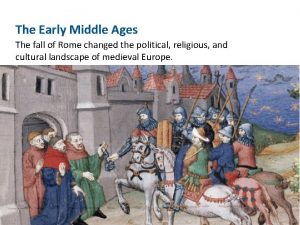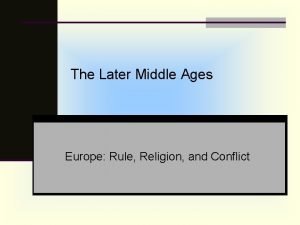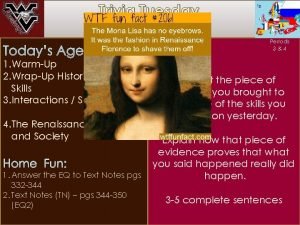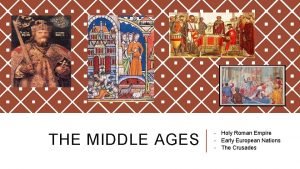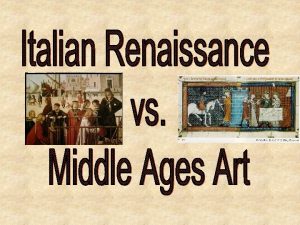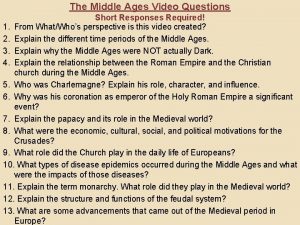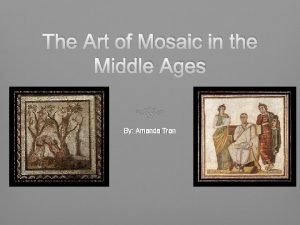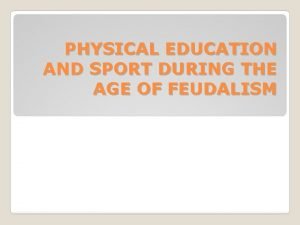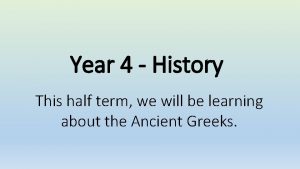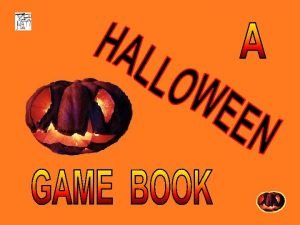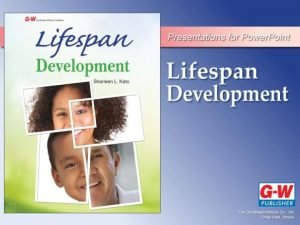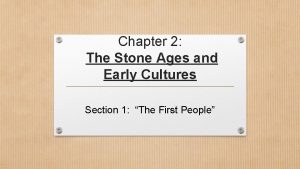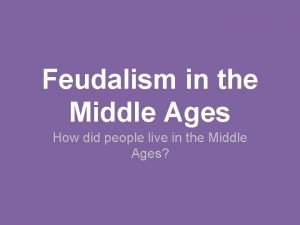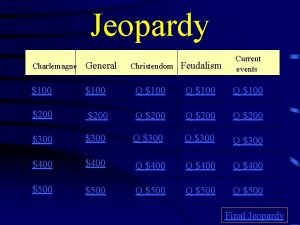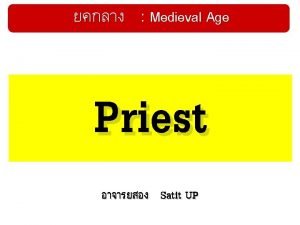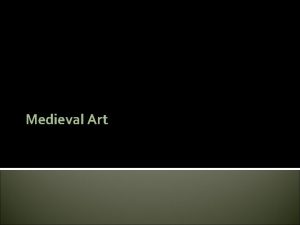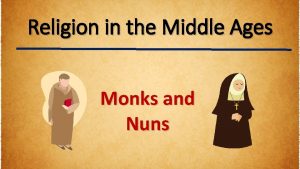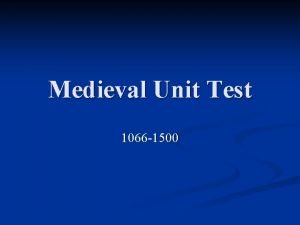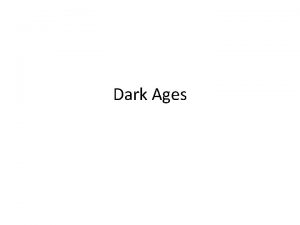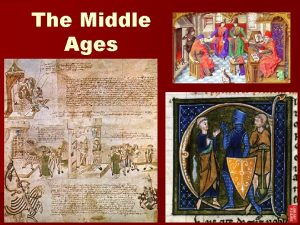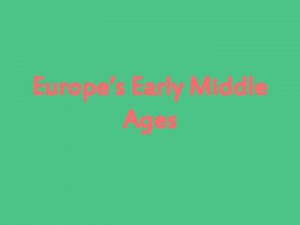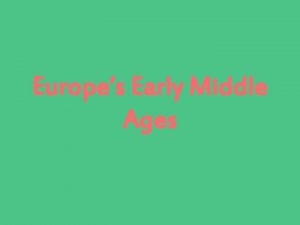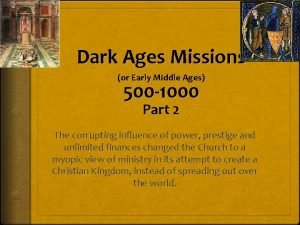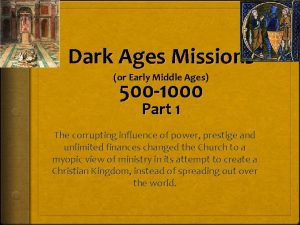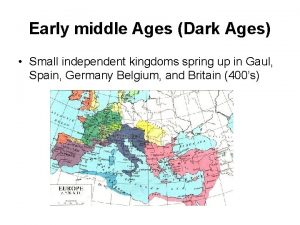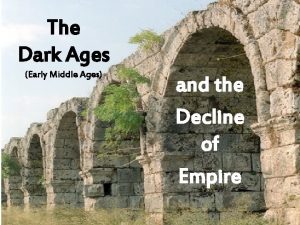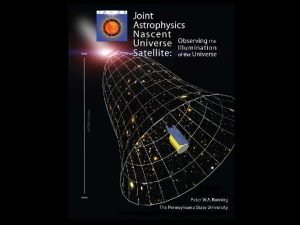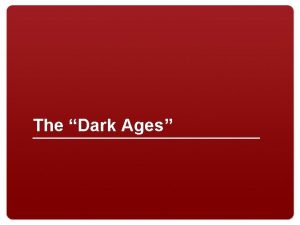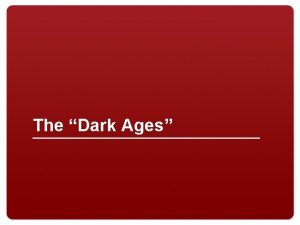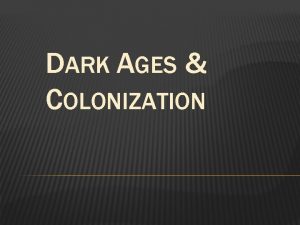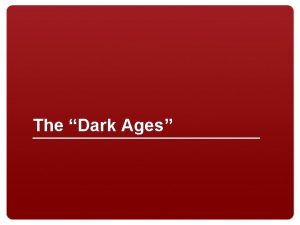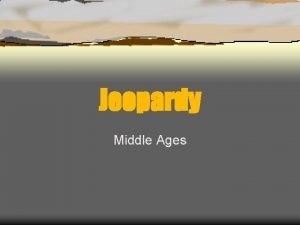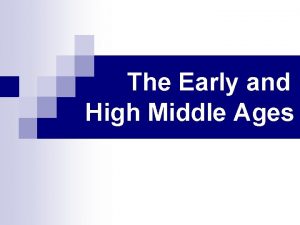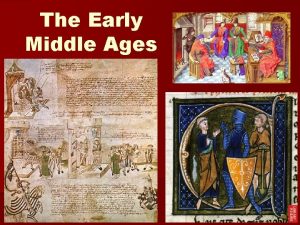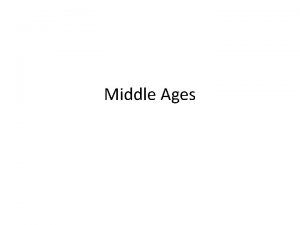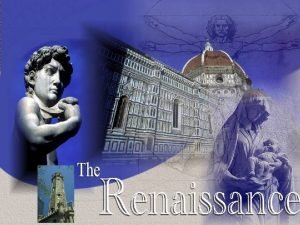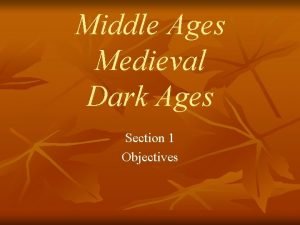The Middle Ages Early Middle Ages n Dark

























- Slides: 25

The Middle Ages

Early Middle Ages n Dark Ages (500 CE- 1000 CE)- scholars named this as a time when the forces of darkness (barbarians) overwhelmed the forces of light (Romans) n Rise of influence of barbarians as Roman Emperors had granted barbarian mercenaries land with the Roman Empire in return for military service and it was these barbarians who eventually became the new rulers

Expanding Influence of the Church n n n Christian Church has become an important political, economic, spiritual and cultural force in Europe Leading officials of Church were the Pope and Patriarch Banning of heresy (holding beliefs that contradict the official religion) conversion by force Eventually in 11 th Century, Church split into two independent branches Eastern Orthodox (Greek) based in Constantinople and Roman Catholic in Rome

You scratch my back… I’ll scratch yours…. n Church was granted favors by Roman Emperors / Kings (land, exemption from taxes, immunity in courts, positions in courts) and in return the Church would endorse kings to help secure their rule n Kings looked to Church to supply educated administrators to help run kingdoms and in return kings would enforce laws that prohibited other religions


The Holy Roman Empire & Charlemagne n n n Charlemagne (Charles the Great) who was a military general and restored Pope Leo III who had been exiled In return, Leo placed a crown on Charlemagne and named him the “Emperor of the Romans” which secured the relationship between Frankish kings and the papacy Charlemagne became the first ruler of the Holy Roman Empire, a dynasty that would last for more than 700 years Charlemagne- imposed order on empire through the Church and state Ordered the standardization of Latin, textbooks, manuals for preaching, schools for clergy and people, new form of handwriting All these promoted education and scholars and produced a precise written language (Latin)


Slaves and Serfs n Slaves made up of conquered peoples n Some treated harshly, while other were treated fairly n Rural slaves became serfs, who worked the land provided labor for owner (in return from protection) n Set up for system of feudalism

Birth of Modern Languages n Development of Middle Ages n New languages born through migration, resettlement, conflict and changes n Old English (Anglo Saxon) began to incorporate words borrowed from Latin and Old French, Old German and Old Norse n Roots of contemporary Spanish, Italian and other Romance languages

Feudalism n n n n n Increasing violence and lawless countryside Weak turn to the strong for protection, strong want something from the weak Feudalism= relationship between those ranked in a chain of association (kings, vassals, lords, knights, serfs) Feudalism worked because of the notion of mutual obligation, or voluntary cooperation from serf to noble A man’s word was the cornerstone of social life Key terms Fief = land given by a lord in return for a vassal’s military service and oath of loyalty Serfs= aka villeins or common peasants who worked the lords land Tithe = tax that serfs paid (tax or rent) Corvee= condition of unpaid labour by serfs (maintaining roads or ditches on a manor)



England was one of the first countries in Europe to develop a strong central monarchy = central government The Magna Carta was a document that limited the power of the king = limited government King John signing the Magna Carta, forced by his nobles to give up some of his power.

Were a series of attempts to gain Christian control of the Holy Land. Pope Urban II called for Christians to join a Crusade at the Council Of Clermont.

Trade increased Kings gained more power Muslim knowledge spread throughout Europe Relations between Christians and Jews worsened

a group of northern German cities/towns focused on promoting and protecting trade As more people began to live in towns, craftspeople began to organize to protect their interest; primary interest was to restrict competition. Merchants asked for charters from kings to establish new towns

Hundred Years War 1. King of England believes that he is the rightful heir to the French throne 2. France declared the regent to be the new king 3. Even though England uses new weapons technology, France wins War of the Roses 1. the Lancasters (red) & the Yorks (white) both used the rose as their family emblem; both wanted the English throne 2. After Edward’s death, a York, his son disappeared; his brother became king 3. Conflict ended when, Henry Tudor becomes king; he is related to both warring families

New Ideas and Culture n Effects of Crusades n Guild and communes n Towns, cities and manors n New thinkers (Thomas Aquinas) and writers n Creation of universities n New art and architecture (gothic, castles) n Knighthood and chivalry n Courtly entertainment (fables, playwrights)

Late Middle Ages Black Death a devastating worldwide pandemic that first struck Europe in the mid 14 th century killed about a third of Europe’s population, an estimated 34 million people.

The Bubonic Plague Called “black death” because of striking symptom of the disease, in which sufferers' skin would blacken due to hemorrhages under the skin Spread by fleas and rats painful lymph node swellings called buboes in the groin and armpits, which ooze pus and blood. damage to the skin and underlying tissue until they were covered in dark blotches Most victims died within four to seven days after infection EFFECTS Caused massive depopulation and change in social structure Weakened influence of Church Originated in Asia but was blamed on Jews and lepers



Illustration of the Black Death from the Toggenburg Bible (1411).

Ideas, Inventions and Key Figures Roger Bacon (gunpowder) Luca Pacioli (Father of Accounting) Johannes Gutenberg (printing press) Christine de Pisan (writer); Geoffrey Chaucer (writer) Joan of Arc (Hundred Year’s War) Pope Urban II (indulgences) Pope Innocent IV and Bernard Gui (inquisitions) Parliamentary Government in England

 Renaissance art vs medieval art
Renaissance art vs medieval art Why are the middle ages called the dark ages
Why are the middle ages called the dark ages Early middle ages
Early middle ages Early middle ages
Early middle ages Dark ages def
Dark ages def American cyclopaedia dark ages
American cyclopaedia dark ages Renaissance vs middle ages
Renaissance vs middle ages Dark ages holy roman empire
Dark ages holy roman empire Dark ages vs renaissance
Dark ages vs renaissance Dark ages video questions
Dark ages video questions Mosaic art in medieval period
Mosaic art in medieval period Feudalism in physical education
Feudalism in physical education Greek dark ages timeline
Greek dark ages timeline Dark matter and dark energy ppt
Dark matter and dark energy ppt In a dark dark town
In a dark dark town Chapter 7 early childhood ages 3 through 5
Chapter 7 early childhood ages 3 through 5 The stone ages and early cultures
The stone ages and early cultures Early cpr and early defibrillation can: *
Early cpr and early defibrillation can: * Feudal system in the middle ages
Feudal system in the middle ages Current events jeopardy
Current events jeopardy Catholic hierarchy chart
Catholic hierarchy chart Characteristic of medieval art
Characteristic of medieval art Naissance renaissance
Naissance renaissance Free form expression floral design
Free form expression floral design Monks and nuns in the middle ages
Monks and nuns in the middle ages The middle ages 1066 to 1485 unit test
The middle ages 1066 to 1485 unit test


